Energy Use in Day Care Centers and Schools
Abstract
:1. Introduction
2. Methods and Studied Buildings
| Type | Year of Completion | No. of Occupants | Gross Area (m2) | AB/AS * | Indoor Climate | Energy |
|---|---|---|---|---|---|---|
| Day care centre | 2008 | 100 | 1290 | 1.35 | S3 and 20% option for increased ventilation | Part of environment program |
| School | 2003 | 3376 | ||||
| School | 2009 | 664 | 7770 | 1.5 | S3 and 20% option for increased ventilation | Part of environment saving program, solar heat, ground cooling |
| School | 2010 | S3 and 20% option for increased ventilation | ||||
| School | 2005 | 235 | 3270 | S3 and demand controlled ventilation with CO2 sensors | Energy and water use measurement and feedback to user | |
| School | 2010 | 705 | 9835 | S3 and 20% option for increased ventilation | Renovation | |
| School | 2009 | 425 | 5300 | S3 and 20% option for increased ventilation | Renovation | |
| Day care centre | 2006 | 113 | 1656 | 1.5 | S3 and 20% option for increased ventilation |
Primary Energy Factors
| Primary Energy Factor | |
|---|---|
| District heating | 0.9 |
| Electricity | 2.2 |
| Oil | 1.0 |
| Pellets and wood | 1.0 |
3. Results
3.1. Building Size and Year of Completion
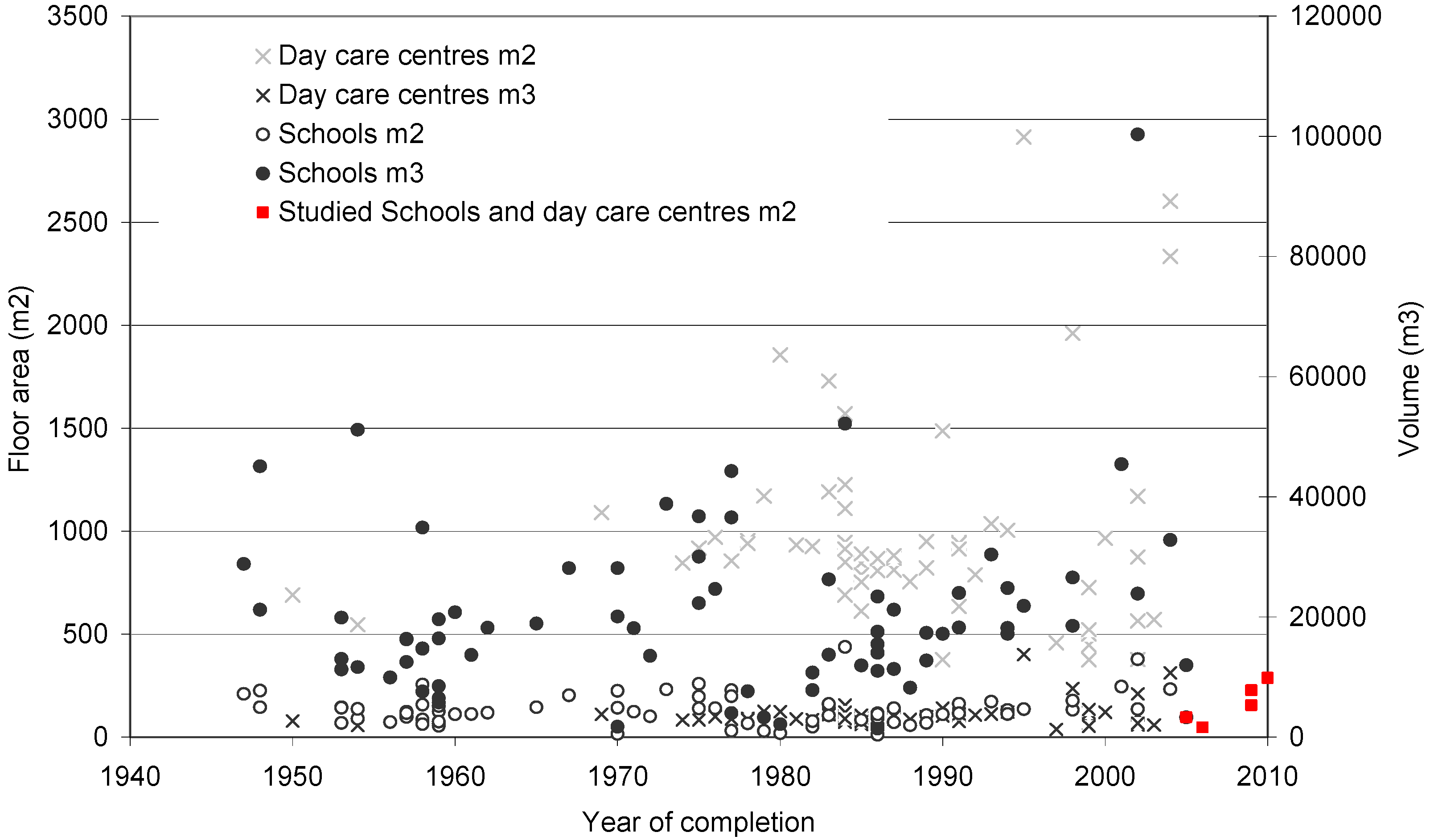
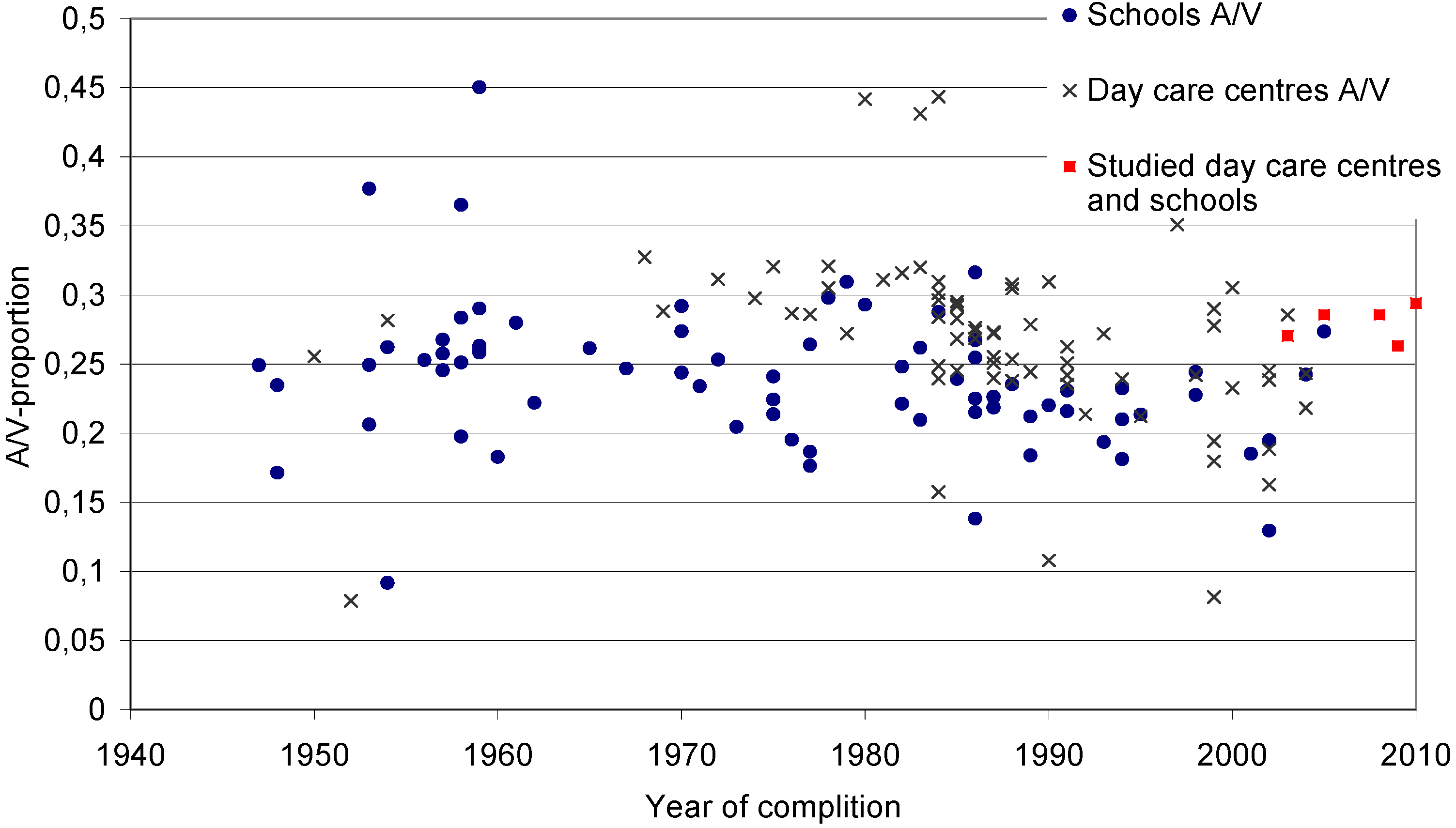
3.2. Thermal Energy Consumption
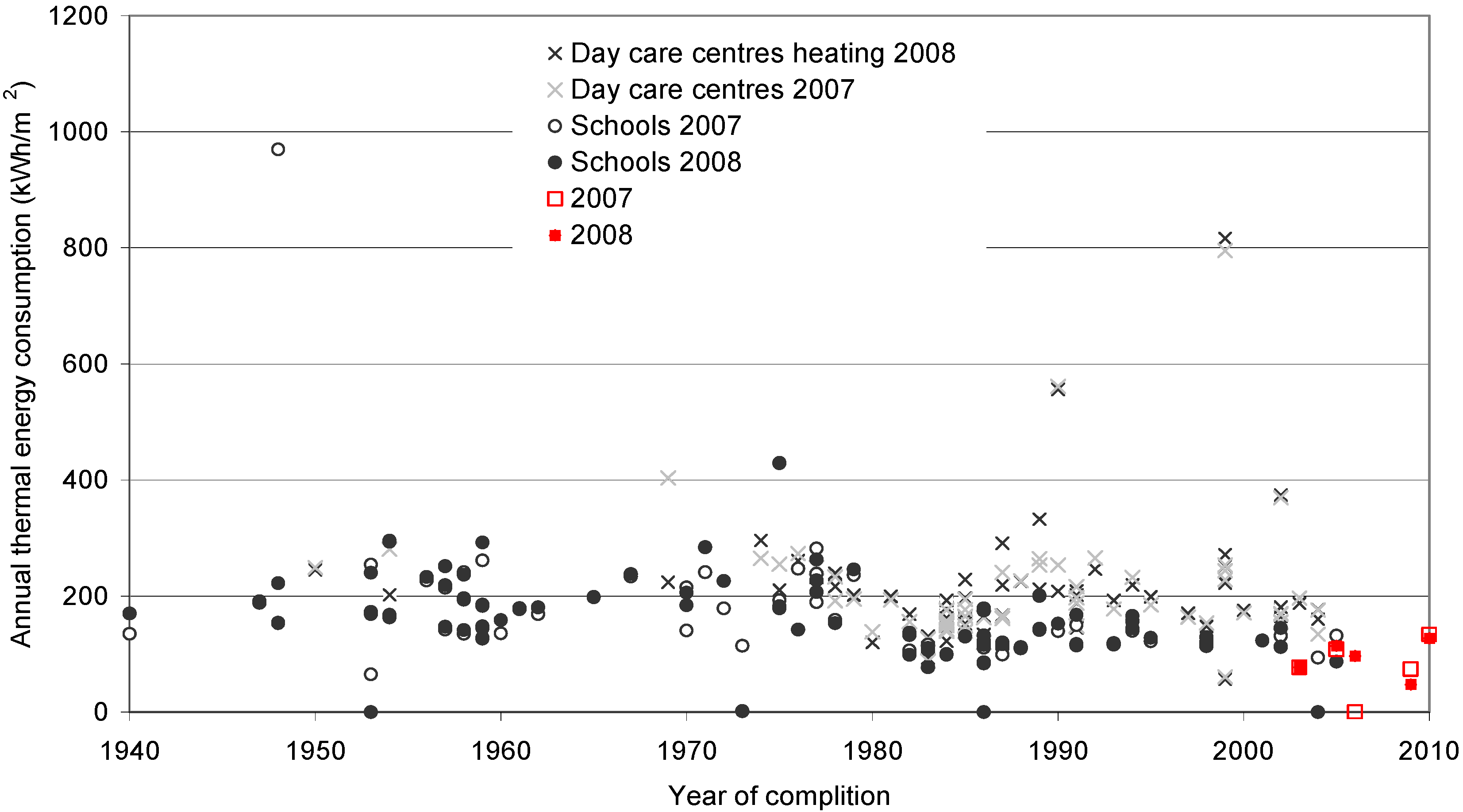
3.3. Electricity Consumption
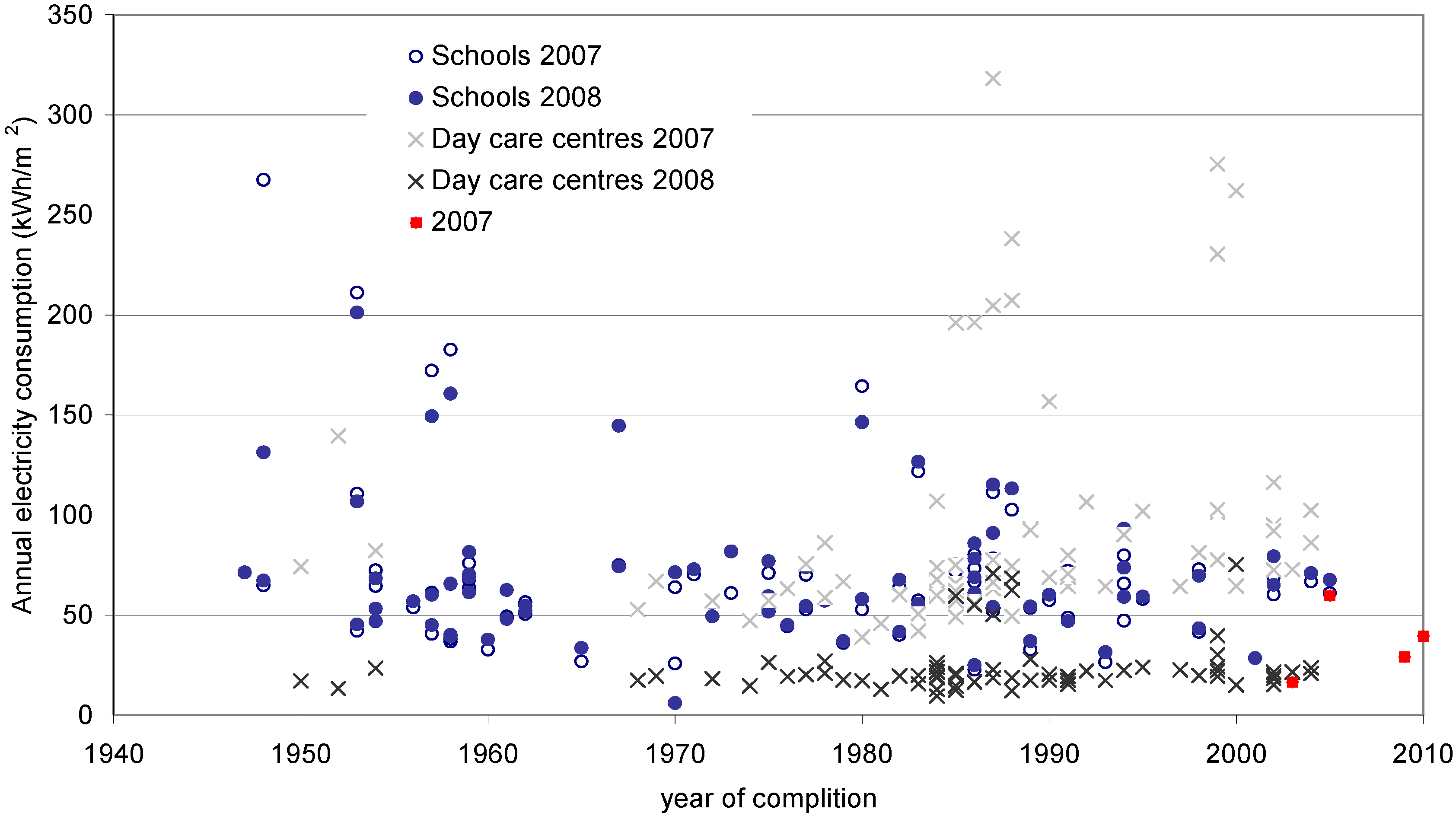
3.4. Primary Energy Consumption

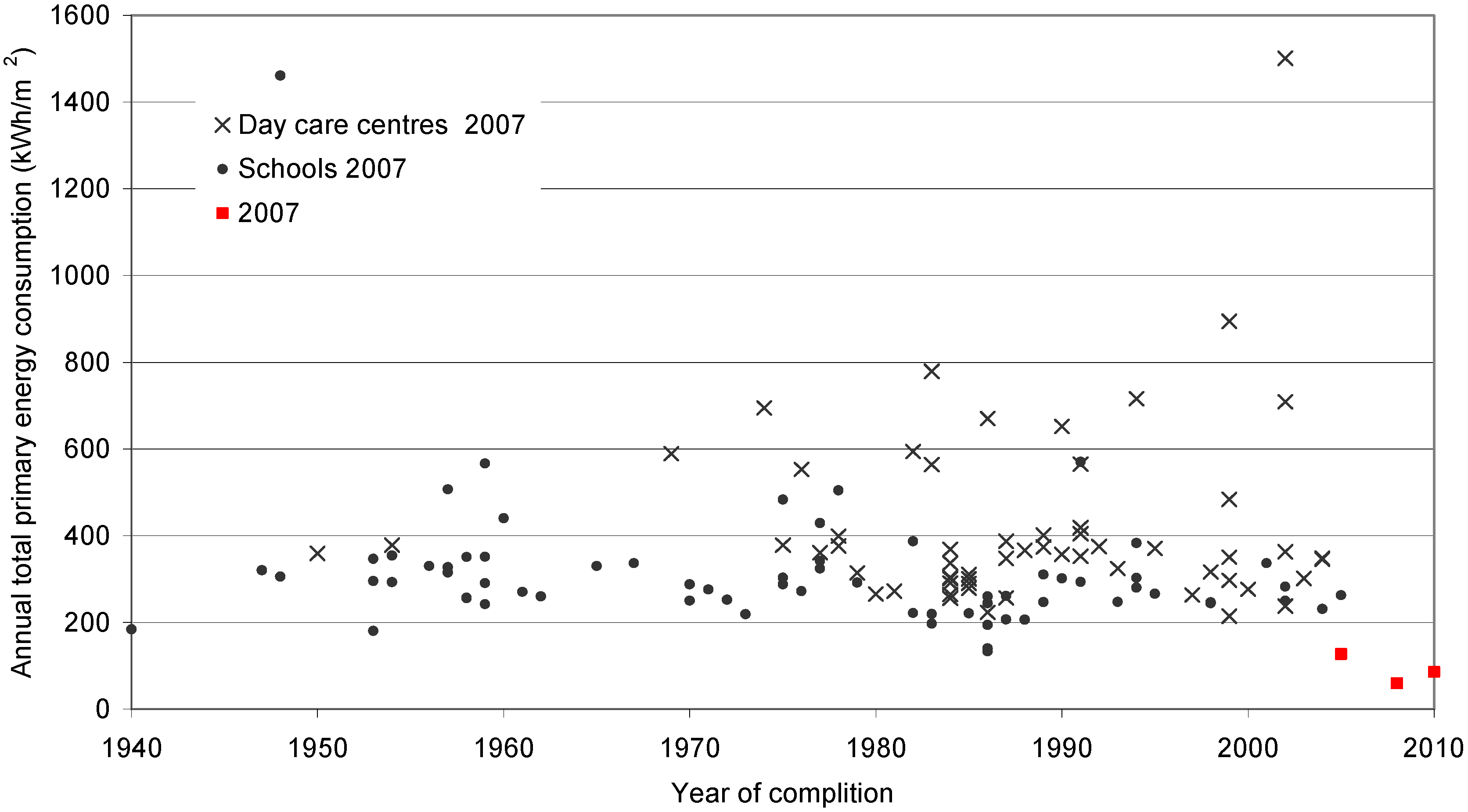
4. Discussion and Conclusions
Acknowledgements
References
- Finnish Government. The Future of Finnish Climate and Energy Policy; 2009. Available online: http://www.valtioneuvosto.fi/toiminta/tulevaisuusselonteko/fi.jsp (accessed on 5 May 2011).
- EU Energy and Transport in Figures, Statistical Pocket Book 2007/2008; European Communities: Brussels, Belgium, 2008.
- Intergovernmental Panel on Climate Change (IPCC). Climate Change 2001: Mitigation, Third Assessment Report, Working Group III; IPCC: New York, NY, USA, 2001. [Google Scholar]
- Recast of the Energy Performance of Buildings Directive (2002/91/EC); COM (2010) 755/SEC(2010) 2821; Commission of the European Communities: Brussels, Belgium, 2010.
- A European Strategic Energy Technology Plan (SET-PLAN); COM (2007) 723 Final. Commission of the European Communities: Brussels, Belgium, 2007. Available online: http://eur-lex.europa.eu/LexUriServ/LexUriServ.do?uri=COM:2007:0723:FIN:EN:PDF (accessed on 22 November 2007).
- Itard, L.; Meijer, F. Towards a Sustainable Northern European Housing Stock: Figures, Facts and Future; IOS Press: Amsterdam, The Netherlands, 2009. [Google Scholar]
- Towards Energy Efficient Buildings in Europe; Final Report. EuroACE: London, UK, 2004. Available online: http://www.euroace.org/EuroACE%20documents/050731%20Towards%20Energy%20Efficient%20Buildings%20in%20Europe%20(Jul%2005%20update).pdf (accessed on 5 May 2011).
- Butala, V.; Novak, P. Energy consumption and potential energy savings in old school buildings. Energy Build. 1999, 29, 241–246. [Google Scholar] [CrossRef]
- Hernandez, O.; Burke, K.; Lewis, J.O. Development of energy performance benchmarks and building energy ratings for non-domestic buildings: An example for Irish primary schools. Energy Build. 2008, 40, 249–254. [Google Scholar] [CrossRef]
- Good Practice Guide. In GPG343: Saving Energy—A Whole School Approach; The Carbon Trust: London, UK, 2005.
- Gaglia, A.; Balaras, C.A.; Mirasgedis, S.; Georgopoulou, E.; Sarafidis, Y.; Lalas, D.P. Empirical assessment of the Hellenic non-residential building stock, energy consumption, emissions and potential energy savings. Energy Convers. Manag. 2007, 48, 1160–1175. [Google Scholar] [CrossRef]
- Santamouris, M.; Balaras, C.A.; Dascalaki, E.; Argiriou, A.; Gaglia, A. Energy consumption and the potential for energy conservation in school buildings in Hellas. Energy 1994, 19, 653–660. [Google Scholar] [CrossRef]
- Santamouris, M.; Mihalakakou, G.; Patargias, P.; Gaitani, N.; Sfakianaki, K.; Papaglastra, M.; Pavlou, C.; Doukas, P.; Primikiri, E.; Geros, V.; et al. Using intelligent clustering techniques to classify the energy performance of school buildings. Energy Build. 2007, 39, 45–51. [Google Scholar]
- Filippín, C. Benchmarking the energy efficiency and greenhouse gases emissions of school buildings in central Argentina. Build. Environ. 2000, 35, 407–414. [Google Scholar] [CrossRef]
- Ding, G. Life cycle energy assessment of Australian secondary schools. Build. Res. Inf. 2007, 35, 487–500. [Google Scholar] [CrossRef]
- Desideri, U.; Proietti, S. Analysis of energy consumption in the high schools of a province in central Italy. Energy Build. 2002, 34, 1003–1016. [Google Scholar] [CrossRef]
- Corgnati, S.P.; Viazzo, S.; Filippi, M. A method for heating consumption assessment in existing buildings: a field survey concerning 120 Italian schools. Energy Build. 2008, 40, 801–809. [Google Scholar] [CrossRef]
- Lemire, N. School and more. ASHRAE J. 2010, 52, 34–38. [Google Scholar]
- Harouni, R.; Nichols, L.; Jean-Louis, M.J. Head of the class for no GHG-school. ASHRAE J. 2006, 48, 22–27. [Google Scholar]
- Citherlet, S.; Clarke, J.A.; Hand, J. Integration in building physics simulation. Energy Build. 2001, 33, 451–461. [Google Scholar] [CrossRef]
- Jonsson, A. Tools and methods for environmental assessment of building products—methodological analysis of six selected approaches. Build. Environ. 2000, 35, 223–238. [Google Scholar] [CrossRef]
- Finnish Ministry of Environment. Permits Related to Land Use and Building; 2010. Available online: http://www.ymparisto.fi (accessed on 5 May 2011).
- Haas, R.; Auer, H.; Biermayr, P. The impact of consumer behavior on residential energy demand for space heating. Energy Build. 1998, 27, 195–205. [Google Scholar] [CrossRef]
- Branco, G.; Lachal, B.; Gallinelli, P.; Weber, W. Predicted versus observed heat consumption of a low energy multifamily complex in Switzerland based on long-term experimental data. Energy Build. 2004, 36, 543–555. [Google Scholar] [CrossRef]
- Hirst, E.; Goeltz, R. Comparison of actual energy saving with audit predictions for homes in the North Central Region of the USA. Build. Environ. 1985, 20, 1–6. [Google Scholar] [CrossRef]
- Finnish Society of Indoor Air Quality and Climate (FiSIAQ). Classification of Indoor Climate 2008; FiSIAQ: Espoo, Finland, 2008. [Google Scholar]
© 2011 by the authors; licensee MDPI, Basel, Switzerland. This article is an open access article distributed under the terms and conditions of the Creative Commons Attribution license (http://creativecommons.org/licenses/by/3.0/).
Share and Cite
Airaksinen, M. Energy Use in Day Care Centers and Schools. Energies 2011, 4, 998-1009. https://doi.org/10.3390/en4070998
Airaksinen M. Energy Use in Day Care Centers and Schools. Energies. 2011; 4(6):998-1009. https://doi.org/10.3390/en4070998
Chicago/Turabian StyleAiraksinen, Miimu. 2011. "Energy Use in Day Care Centers and Schools" Energies 4, no. 6: 998-1009. https://doi.org/10.3390/en4070998




